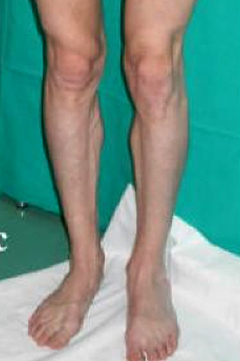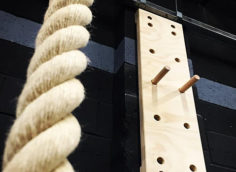For most of us in the gym, training calves is a bitch, plain and simple. If you weren't genetically blessed with good calves, you've got to suffer long and hard to make any improvements in the lower legs. But even the guys with good genetics often have to work pretty hard to take their calves up to the next level.
Good genetics
Not-so-good genetics
I'm part of the not-genetically gifted lifters. A college strength coach once called me De-calf-inated, and it pissed me off, but he was right. At close to 200 pounds, I had 14-inch calves, they weren't well-defined, and they were weak.
The Cure for Little Lower Legs
Since my calves don't respond to just anything, I've had to work that much harder to make progress. I wish I could say that they're spectacular now, but I can't. They're significantly better than before, but not spectacular by any means. However, because my gains come slowly, if certain programs can work for me, they can pretty much work for anybody.
I've found two calf programs to be most useful. The first was Charles Poliquin's routine, "Turn Those Calves into Cows," from his book The Poliquin Principles. My calves got much stronger and noticeably bigger from that routine, which I followed for about 18 months.
After that, I tried every variation from super high-rep programs to heavy weight routines, and nothing made much of a difference, until I realized that if I wanted something done right, I had to plan it myself. This routine, which has worked very well, is pretty simple. But I think simple is good for the smaller muscles.
Of course, the whole idea is to make the term "smaller muscle" inaccurate
The Plan
- Train your calves on three non-consecutive days each week.
- Use just one exercise each day.
- Do three heavy sets, with the same weight, and one back-down set per exercise (except for the third workout. It has a special set/rep system.)
- Increase the weight or reps each week.
- Do an extreme calf stretch after the workout.
- Take two full weeks off after every six to eight weeks of serious calf training.
Workout One
Here are the specifics of what I did, you may want to adjust the details to better suit your gym or needs. I trained calves on Monday, Wednesday, and Friday, but you can do whichever non-consecutive days work for your schedule.
My three exercises were Smith machine calf raises on Monday, seated calf raises on Wednesday, and the standing calf raise machine on Friday.
Chalk up another legit use for the Smith machine
For the Smith machine calf raise, you want to go pretty heavy and still have a decent range of motion (ROM). I think most men should be able to start off with two plates on each side, or three plates if you've been training your calves regularly. You may eventually be able to work up to four or five plates per side.
It's three sets of the same weight, with a minimum of 15 reps per set (shoot for 20 or more, all the way up to 50). Go until failure, or until your ROM significantly shortens. Rest time is two to three minutes between sets. I often get 25 reps on my first set, 20-22 on my second, and 18-20 on my third. Maintain good form, try to squeeze at the top, and get a good stretch at the bottom.
After those three sets, cut the weight almost in half (remove one or two plates from each side) and do one more set with a slow tempo. Again, use a full ROM, squeeze hard at the top for a 2-count, and pause for a 2-count at the bottom in a deep stretch.
A good block for calf raises allows a complete stretch at the bottom
You'll probably get close to the same number of reps on this set as the others; even though the weight is much lighter, you are already tired. The slower tempo and emphasized squeezing makes it even harder.
When you've finished those killer sets, you're going to do an extreme calf stretch, "DC-style." I like to use the leg press (in calf raise position) with around 180 pounds, the super squat machine, or a basic seated position with the toes elevated.
Hold the stretch for 45-60 seconds, but the last 30 seconds should be pretty painful. There's a lot of tendinous tissue in the calf area, and I believe that it's possible that the surrounding connective tissue could hold back the overall size of the calf. We want to stretch that out as much as possible.
Workout Two
On Wednesday, it's the seated calf raise for a bit more emphasis on the soleus. I know the soleus is more slow twitch and the gastroc is more fast twitch, but I think you need to hammer both of them with pretty high reps and a good amount of weight.
Most people use about half of their Smith machine weight on the seated calf raise, but choose a weight that's good for you, it might be less if you don't do seated raises very often.
The sets and reps are the same as in Workout One: three sets with the same weight, going heavy but still getting the full ROM, followed by one back-down set with about the half the original weight. Go slow with a pause at the top and bottom, and really squeeze it. Finish with another 45-60 second extreme stretch.
Getting to know your posterior lower leg
Workout Three
On Friday, it's a little different. If you thought the first two days were tough, you're going to love this... and by love, I mean hate, fear, and cry afterwards. I call this exercise Carl's calf raise because that's the name of the guy who showed it to me (and he's got those spectacular calves I'm looking for).
We'll use the standing calf machine. Start off lighter than normal, with 50-75% of what you'd use for a standard set of 15. The plan is to do one rep with a squeeze at the top, and then get into the bottom position, still supporting the weight, and stretch for about 10 seconds. Then do another rep, and repeat the stretch, for 12-15 reps total.
One trick I use to make it a bit easier is to look at a clock with a second hand during my set. Just as the second hand is on the 12, I do one rep and then get into the bottom position. Every time the second hand completes 10 seconds (on the 2, the 4, the 6, etc.), I do another rep.
A single set lasts two minutes long, but that last minute is a bitch. Just to be clear you're "resting" in the bottom position, but the weight is still fully supported by you, not the machine. You're under continuous tension for two minutes.
Do this for two or three sets. There is no back-down set on this exercise. The exercise itself incorporates an extreme stretch, but follow it up with the usual intense stretch at the end, just like the other workouts.
Standing calf raise, near bottom and at the top
Charting Your Progress
Each week, you need to make the workouts harder, with the possible exception of Carl's calf raises, which can be bumped up every other week or every month. For the Smith machine calf raise, increase the weight by 5-10 pounds per week, every week. With the seated calf raise, increase the weight 2.5-5 pounds per week. And on Carl's calf raise, go up one machine plate, or about 10-20 pounds, every two to four weeks.
Try not to skip a workout during this program. If you do, add the exercise you missed to your next workout. So if you punked out of training on Monday, it's Smith machine raises and seated raises on Wednesday. After you've finished six to eight weeks of this plan, take two full weeks off.
When you come back, use the same weight you were using on your last week of the program. Occasionally, you can intentionally detrain the calves and this forces them to respond again, and yields better overall results.
The first week back will be hard and you may get sore, but that's good, we want to fatigue the muscle. Go through it for another six or eight weeks, and then take time off again. You'll get better results with the time off, rather than staying on the program without any time off.
You might notice that there are no specific tibialis anterior exercises. I see that muscle as separate from the calf, and I'm thinking plantar flexors when I hear that term. But I have no problem with you training the tibialis, if you want to. The same ideas of using higher reps, and gradually increasing the weight, can work there as well.
Wrap-up
There's not much variety in this program, but that's okay. I believe that the more distal muscles (forearms and calves) really don't need much variety, just consistent training and progressive overload. If you vary things too much, it becomes difficult to use comparable loads. Remember: variation, while it can be good, is the enemy of progressive overload.
I suggest you measure your calves at the beginning of this program, and then every month (or even every week). Measure them both standing and seated to see any changes. Don't expect miracles, but 1/8 of an inch here and 1/8 there will add up over time. I've added 3/4 of an inch on my calves, in both measurements, in three months of training.
Give it a solid two or three months and watch what happens. Make sure you post your results, good or bad. Hopefully, one day we'll know what the absolute, perfect calf routine is. Until then, give this one a try.











